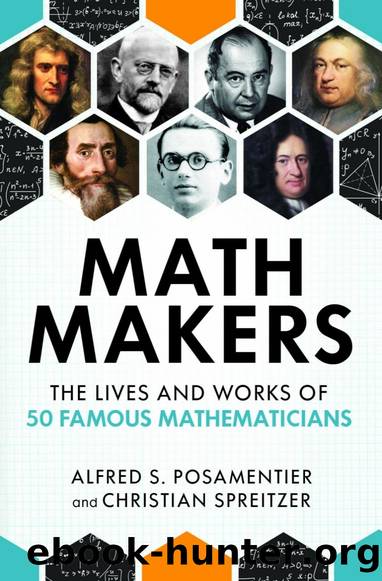Math Makers: The Lives and Works of 50 Famous Mathematicians by Alfred S. Posamentier

Author:Alfred S. Posamentier [Posamentier, Alfred S.]
Language: eng
Format: epub
ISBN: 9781633885202
Google: 3XQ_vQEACAAJ
Amazon: 1633885208
Goodreads: 44131326
Published: 2019-12-06T16:18:55+00:00
Lorenzo Mascheroni: Italian (1750â1800) 221
Figure 26.10
Figure 26.11
In figure 26.11, we draw circle ( A, x), where radius length x is large enough to intersect circle ( O, r) in two points, S and T. The midpoints of the major and minor arcs of ST, are P and R. This becomes a bit more complicated and will be shown in the following manner.
In the interest of completing the above argument, we will now focus our attention on bisecting a given arc ST. To begin our construction (see fig.
26.12) we will let OS = OT = r, where O is the center of the circle of which ST is an arc. We will let the distance between S and T be equal to d, and then draw the circle ( O, d). We then draw the circles ( S, SO) and ( T, TO), which will intersect the circle ( O, d) at points M and N, respectively. Next, we draw arcs ( M, MT) and ( N, NS); each will meet at point K. By drawing arcs ( M, OK) and ( N, OK), we find that their points of intersection, C and D, are the desired midpoints of the arcs ST.
In order to demonstrate why this construction does what is purported to have been done, namely to find the midpoints of arc ST, we will draw some auxiliary lines to help explain the construction as shown in figure 26.13.Letâs first look at quadrilaterals SONT and TOMS. These quadrilaterals are parallelograms since both pairs of opposite sides are congruent. This allows us to conclude that the points M, O, and N are collinear. Since CN
= CM, and KN = KM, we then can conclude that KC and MN are perpendicular at O. We can also conclude that CO ⥠ST. Therefore, CO bisects the segment ST, and consequently the arc ST. Our remaining task is merely to show that the point C lies on circle ( O, r), or to show that CO = r.
In order to do this, we will rely on a useful theorem in geometry that states that the sum of the squares of the measures of the sides of a parallelogram equals the sum of the squares of the measures of the diagonals.2
Applying this to parallelogram SONT, we get the following: ( SN)2 + ( TO)2 =
2( SO)2 + 2( ST)2 or ( SN)2 + r 2 = 2 r 2 + 2 d 2 or, which gives us ( SN)2 = r 2 + 2 d 2 (I)
By applying the Pythagorean theorem to right â KON, we obtain the following:
( KN)2 = ( NO)2 + ( KO)2. However, since KN = SN, we have:
Download
This site does not store any files on its server. We only index and link to content provided by other sites. Please contact the content providers to delete copyright contents if any and email us, we'll remove relevant links or contents immediately.
| Applied | Geometry & Topology |
| History | Infinity |
| Mathematical Analysis | Matrices |
| Number Systems | Popular & Elementary |
| Pure Mathematics | Reference |
| Research | Study & Teaching |
| Transformations | Trigonometry |
Weapons of Math Destruction by Cathy O'Neil(5068)
Factfulness: Ten Reasons We're Wrong About the World – and Why Things Are Better Than You Think by Hans Rosling(4038)
Factfulness_Ten Reasons We're Wrong About the World_and Why Things Are Better Than You Think by Hans Rosling(2764)
Descartes' Error by Antonio Damasio(2755)
A Mind For Numbers: How to Excel at Math and Science (Even If You Flunked Algebra) by Barbara Oakley(2699)
TCP IP by Todd Lammle(2655)
Applied Predictive Modeling by Max Kuhn & Kjell Johnson(2499)
Fooled by Randomness: The Hidden Role of Chance in Life and in the Markets by Nassim Nicholas Taleb(2429)
The Book of Numbers by Peter Bentley(2419)
The Tyranny of Metrics by Jerry Z. Muller(2417)
The Great Unknown by Marcus du Sautoy(2200)
Once Upon an Algorithm by Martin Erwig(2157)
Easy Algebra Step-by-Step by Sandra Luna McCune(2134)
Practical Guide To Principal Component Methods in R (Multivariate Analysis Book 2) by Alboukadel Kassambara(2102)
Lady Luck by Kristen Ashley(2086)
Police Exams Prep 2018-2019 by Kaplan Test Prep(2045)
Linear Time-Invariant Systems, Behaviors and Modules by Ulrich Oberst & Martin Scheicher & Ingrid Scheicher(1989)
All Things Reconsidered by Bill Thompson III(1968)
Secrets of Creation, Volume 1: The Mystery of the Prime Numbers by Watkins Matthew(1876)
